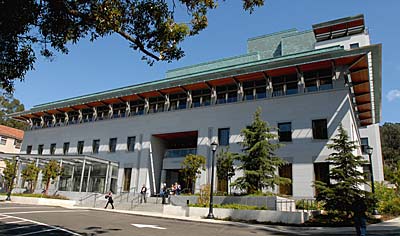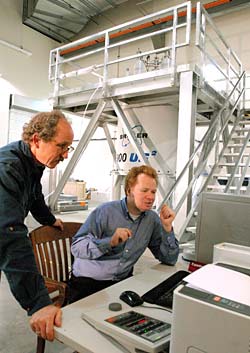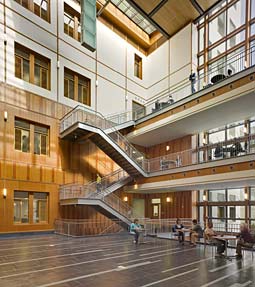UC Berkeley Press Release
 |
The exterior of Stanley Hall is clad in Sierra white granite and copper, complementing the nearby Beaux Arts buildings on campus. (Peg Skorpinski photo) |
Stanley Hall dedication heralds new era of bioscience innovation
BERKELEY – When Stanley Hall, the most recently completed building at the University of California, Berkeley, is officially dedicated on Friday (Sept. 28), it will represent much more than an increase of much-needed laboratory, office and classroom space. The state-of-the-art facility represents the promise of a new era in interdisciplinary bioscience research on campus and will be a catalyst for innovations that may one day lead to new treatments or preventions for diseases, more environmentally friendly sources of energy and better ways to clean up pollutants.
| Dedication features |
• Subatomic particles and giant magnets |
"Today, life science research is progressing toward problems of increasing scale and complexity, with solutions rooted in the quantitative sciences: mathematics, physics, chemistry and engineering," said Chancellor Robert J. Birgeneau. "The research that will be stimulated here, at the crossroads of multiple disciplines, holds the promise of transforming human health, energy and the environment," he said.
"Designing a building to truly foster interdisciplinary research isn't about dividing up lab and office space among different departments," said Susan Marqusee, associate director at UC Berkeley of the California Institute for Quantitative Biosciences (QB3), professor of molecular and cell biology, and the faculty leader on the Stanley Hall replacement project.
Stanley Hall is the first building on campus in which decisions about space allocation support a multidisciplinary program, rather than being controlled by a department or college.
"We actually dispensed with the notion of departments altogether and instead focused on the different types of science that would take place in the facility," she said. Marqusee, a leading expert on research in protein folding, worked closely on the building's design with the faculty and the architectural firm Zimmer Gunsul Frasca Architects LLP.
 UC Berkeley chemistry professor David Wemmer (left), director of the nuclear magnetic resonance facility at Stanley Hall, and Jeffrey Pelton, facility manager, examine data obtained from the 7-ton, 900 megahertz magnet seen in the background. The magnet, one of only a few in operation worldwide,will be used by researchers throughout Central and Northern California. (Peg Skorpinski photo) |
Under the roof of the 11-story building - three floors of which are below ground - one can find a wide swath of the campus community, from undergraduates to award-winning scientists, including one Nobel laureate. Along with modern classrooms and instructional spaces, the building has 33 wet laboratories and eight computational suites that will be used by bioengineers, biologists, chemists, physicists, mathematicians and computer scientists. Altogether, there is space for 650 faculty, students and staff members, many of whom began moving into Stanley Hall in April.
That six of the departments represented in Stanley Hall are ranked in the top 10 nationally illustrates the breadth of excellence represented in the building, not to mention at UC Berkeley.
Named for the late Wendell M. Stanley, a UC Berkeley biochemist and virologist who received the Nobel Prize in Chemistry in 1946, the building measures approximately 285,000 gross square feet, more than four times the size of the outdated, seismically poor research building it succeeds.
The plans for the new Stanley Hall began in the late 1990s with a vision led by three distinguished UC Berkeley faculty members: Paul Gray, professor of electrical engineering, who was then dean of the College of Engineering; Graham Fleming, professor of chemistry; and the late Daniel Koshland Jr., professor of molecular and cell biology. Dubbed the "Gang of Three," they proposed a building that would not only enable collaborations among scientists from different disciplines, but one that would make such alliances inevitable.
"The goal all along was to bring together brilliant minds from a range of physical, biological and engineering sciences to catalyze the kinds of synergies that would lead to major new discoveries across the whole field of bioscience," said Fleming, UC Berkeley director of QB3 and deputy laboratory director at Lawrence Berkeley National Laboratory (LBNL). "This commitment to interdependent research is necessary to make transformational leaps in the biosciences."
As an example, Fleming noted that approaching cellular components as one would the parts of an electronics chip and then manipulating them to behave in new ways has formed the basis of a fledgling new field of research - synthetic biology. And computational biology, which incorporates the techniques of computer science, mathematics and statistics into the field of biology, was critical to the successful sequencing of the human genome.
"Making progress toward solving the grand challenges of biological sciences pushes the limits of each discipline," he said. "Finding solutions that reach beyond these limitations requires scientific engagement by scientists who are not only experts in their fields, but who can work conversantly across fields. Stanley Hall and QB3 create an environment that supports this intellectual engagement."
 A number of laboratories look out into the 5-story atrium of Stanley Hall. (Robert Canfield photo) |
Just as Stanley Hall provides the physical infrastructure to support science that crosses boundaries between traditional scientific disciplines, QB3 provides the program infrastructure that breaks down the boundaries between departments and colleges. At UC Berkeley, QB3 provides specialized services for projects that involve multiple investigators, campuses and institutions, with the result that the campus has recently received major funding for new research in synthetic biology, energy biosciences and other multidisciplinary areas.
The Stanley Hall project also represents phase one of the UC Berkeley Health Sciences Initiative, a $400 million campus-wide fundraising campaign to support the construction of two new interdisciplinary research centers at UC Berkeley: Stanley Hall and the Li Ka Shing Center for Biomedical and Health Sciences. Groundbreaking for the latter facility is scheduled for early 2008.
Stanley Hall houses specialized core research facilities, including a nuclear magnetic resonance (NMR) facility that was specifically designed to house a powerful, 900 megahertz magnet, one of only a few in operation worldwide. The 7-ton device, funded by a $6 million grant from the National Institutes of Health, will be used by researchers throughout Central and Northern California.
Other support facilities at Stanley Hall include the Biomolecular Nanotechnology Center, dedicated to the fabrication of bio-MEMS and microrobotic devices; the Keck MacroLab, designed to support protein expression studies; the Vincent Coates Functional Genomics Center; and mass spectrometry and proteomics facilities.
Scientists from other universities and industry will have opportunities to use the Stanley Hall facilities, Fleming said, which will stimulate active partnerships between these researchers.
Jeanne Stachowiak, a UC Berkeley Ph.D. student in mechanical engineering and a member of bioengineering associate professor Dan Fletcher's lab on the sixth floor of Stanley Hall, said the sharing of equipment and expertise has already become commonplace in the building.
"If we weren't on the same floor, or even in the same building, it would be less likely that we'd even know about each other's resources," said Stachowiak. "The way the space is configured lets students build their own collaboration. We talk while having lunch, and we might find out that a particular lab has a tool that could be useful in our research. It helps students create their own community."
For Professor Marqusee, the official opening of Stanley Hall represents the culmination of an exciting vision. "This building has been my passion for the last 10 years. It embodies the best of how science can affect the design of a building, and how the design of a building can transform the science that takes place within its walls," she said.
She noted, however, the significant absence of Daniel Koshland, one of Stanley Hall's most enthusiastic champions. An eminent biochemist and a former editor of the journal Science, he died two months ago.
"I'm glad that Dan Koshland was able to see the vision realized, even though he won't be able to witness and enjoy the rewards that promise to come from what we've created here in Stanley Hall," said Marqusee, who worked closely with Koshland on this project and considers him a mentor. "It's been an amazing and rewarding journey."
The public is invited to get a first-hand look at Stanley Hall at the community celebration of the building's opening from 1-4 p.m. on Saturday, Sept. 29.


 The vision
The vision The teaching
The teaching The magnet
The magnet The grad student
The grad student